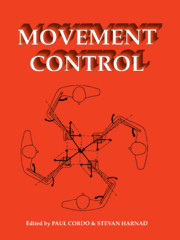Book contents
- Frontmatter
- Contents
- Preface
- 1 Does the nervous system use equilibrium-point control to guide single and multiple joint movements?
- 2 Does the nervous system depend on kinesthetic information to control natural limb movements?
- 3 Can sense be made of spinal interneuron circuits?
- 4 Implications of neural networks for how we think about brain function
- 5 Do cortical and basal ganglionic motor areas use “motor programs” to control movement?
- 6 Functional heterogeneity with structural homogeneity: How does the cerebellum operate?
- 7 Are movement parameters recognizably coded in the activity of single neurons?
- 8 The representation of egocentric space in the posterior parietal cortex
- Open Peer Commentary and Authors' Responses
- References
- Index
4 - Implications of neural networks for how we think about brain function
Published online by Cambridge University Press: 11 December 2009
- Frontmatter
- Contents
- Preface
- 1 Does the nervous system use equilibrium-point control to guide single and multiple joint movements?
- 2 Does the nervous system depend on kinesthetic information to control natural limb movements?
- 3 Can sense be made of spinal interneuron circuits?
- 4 Implications of neural networks for how we think about brain function
- 5 Do cortical and basal ganglionic motor areas use “motor programs” to control movement?
- 6 Functional heterogeneity with structural homogeneity: How does the cerebellum operate?
- 7 Are movement parameters recognizably coded in the activity of single neurons?
- 8 The representation of egocentric space in the posterior parietal cortex
- Open Peer Commentary and Authors' Responses
- References
- Index
Summary
Abstract: Engineers use neural networks to control systems too complex for conventional engineering solutions. To examine the behavior of individual hidden units would defeat the purpose of this approach because it would be largely uninterpretable. Yet neurophysiologists spend their careers doing just that! Hidden units contain bits and scraps of signals that yield only arcane hints about network function and no information about how its individual units process signals. Most literature on single-unit recordings attests to this grim fact. On the other hand, knowing a system's function and describing it with elegant mathematics tell one very little about what to expect of interneuronal behavior. Examples of simple networks based on neurophysiology are taken from the oculomotor literature to suggest how single-unit interpretability might decrease with increasing task complexity. It is argued that trying to explain how any real neural network works on a cell-by-cell, reductionist basis is futile and we may have to be content with trying to understand the brain at higher levels of organization.
- Type
- Chapter
- Information
- Movement Control , pp. 42 - 53Publisher: Cambridge University PressPrint publication year: 1994
- 7
- Cited by

